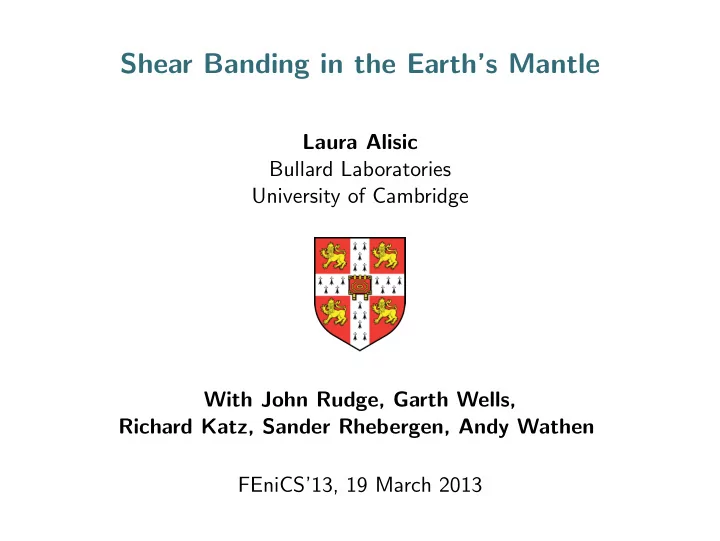

Shear Banding in the Earth’s Mantle Laura Alisic Bullard Laboratories University of Cambridge With John Rudge, Garth Wells, Richard Katz, Sander Rhebergen, Andy Wathen FEniCS’13, 19 March 2013
Mantle convection Hot fluid mantle is heated from below, cooled at the top Convection drives cold stiff plates → Coupled system [ U. Alberta ]
Ridges and subduction zones Plates created at mid-oceanic ridges, move towards trenches, recycled in subduction zones Mantle properties determine plate motion Continental crust Arc Lithosphere Ridge Subduction Mantle Hot spot [ Hirschmann & Kohlstedt, 2012 ] Mantle-magma interaction important in subduction zones: melting in mantle wedge, formation of island arcs
Zooming in: convection and compaction Deformation processes on mm scale influence large-scale features Mantle is partially molten → flow of magma through compacting and convecting porous matrix Shear causes melt to segregate → shear bands → mechanism for larger-scale melt transport [ Holtzman et al, 2003 ]
Zooming in: convection and compaction Compare numerical models with shear banding in laboratory experiments → material properties? [ Katz et al, 2006 ]
Inclusion in porous medium under simple shear Melt mapping in laboratory experiment: olivine + 10% MORB γ = 1 . 0 γ = 2 . 0 [ Chao Qi & David Kohlstedt ]
Inclusion in porous medium under simple shear Is formation of shear bands dominant over compaction around the inclusion? What determines this balance? Is there asymmetry between melt enrichment and depletion? What affects this asymmetry? → nonlinearity, viscosity ratios, total strain
Equations: Compaction and advection Conservation of mass for the solid phase: ∂φ ∂t + v s · ∇ φ = (1 − φ ) ∇ · v s + Γ (1) ρ s Conservation of mass for the two-phase mixture: � 1 � ∇ · v + Γ∆ = 0 (2) ρ Conservation of momentum for the fluid: ∇ · ( φ σ f ) + φρ f g − F = 0 (3) Conservation of momentum for the solid: ∇ · ((1 − φ ) σ s ) + (1 − φ ) ρ s g + F = 0 (4)
Equations Compaction and advection simplified: ∂φ ∂t + v s · ∇ φ − (1 − φ ) ∇ · v s = 0 (5) � − K φ � ∇ · ∇ P + v s = 0 (6) µ f � ( ζ φ − 2 � η φ ( ∇ v s + ∇ v s T ) � � ∇ P = ∇ · + ∇ · 3 η φ ) ∇ · v s (7) [ after McKenzie, 1984 ]
Porosity-dependent rheology Permeability K φ = φ 2 (8) Bulk viscosity ζ φ = 1 (9) φ Shear viscosity η φ = η 0 e − α ( φ − φ 0 ) (10) Compaction length � � � K 0 ζ 0 + 4 δ c = 3 η 0 (11) µ f
Benchmark 1: Compaction around sphere Analytical solution � − 4 D r 4 + 2 FK 2 ( r ) � v s = E · x r 2 (12) � � − 2 C r 4 + 8 D r 6 − FK 3 ( r ) + ( x · E · x ) x r 3 a 4 K ′ 2 ( a ) C = − 2 ( a ) , (13) 4 ξK 1 ( a ) − a 2 K ′ D = a 4 4 a 3 ξK 2 ( a ) 4 + 2 ( a ) , (14) 4 ξK 1 ( a ) − a 2 K ′ 8 aξ F = 2 ( a ) , (15) 4 ξK 1 ( a ) − a 2 K ′
Benchmark 1: Compaction around sphere
Benchmark 2: Plane wave Initial condition φ i ( x i , y i ) = 1 . 0 + A cos ( k 0 x i sin( θ 0 ) + k 0 y i cos( θ 0 )) (16) Analytical growth rate of planar shear bands s a = − 2 αξ (1 − φ 0 ) k x k y ˙ (17) k 2 + 1 φ 0 Numerical growth rate s n = (1 − φ 0 ) ˙ ∇ · v s (18) φ 0 A [ Spiegelman, 2003 ]
Benchmark 2: Plane wave Porosity and velocity perturbation at γ = 0
Benchmark 2: Plane wave Porosity and velocity perturbation at γ = 1 . 5
Benchmark 2: Plane wave Porosity and velocity perturbation at γ = 3 . 0
Benchmark 2: Initial angle Increase in initial angle of porosity perturbation 0.09 0.068 0.045 Shear band growth rate 0.023 sdot_num 0 sdot_S03 sdot_T12 -0.023 -0.045 -0.068 -0.09 30 60 90 120 150 180 Initial angle (degrees) Growth rate depends on initial shear band angle Fit analytical rates well
Benchmark 2: Perturbation amplitude Error with increase in porosity perturbation amplitude 0.02 Relative error in shear band growth rate 0.015 rel_error_S03 0.01 rel_error_T12 0.005 0 -6 -5 -4 -3 -2 -1 log10 amplitude Error increases for increasing perturbation amplitude Small perturbation assumption breaks down � 10 − 2
Pressure shadows and shear bands Initial porosity perturbation amplitude 10 − 3
Pressure shadows and shear bands Initial porosity perturbation amplitude 10 − 2
Pressure shadows and shear bands What affects relative importance? Nonlinearity of porosity dependence α Ratio of bulk to shear viscosity ζ 0 /η 0 Amplitude of initial perturbation A
Recommend
More recommend